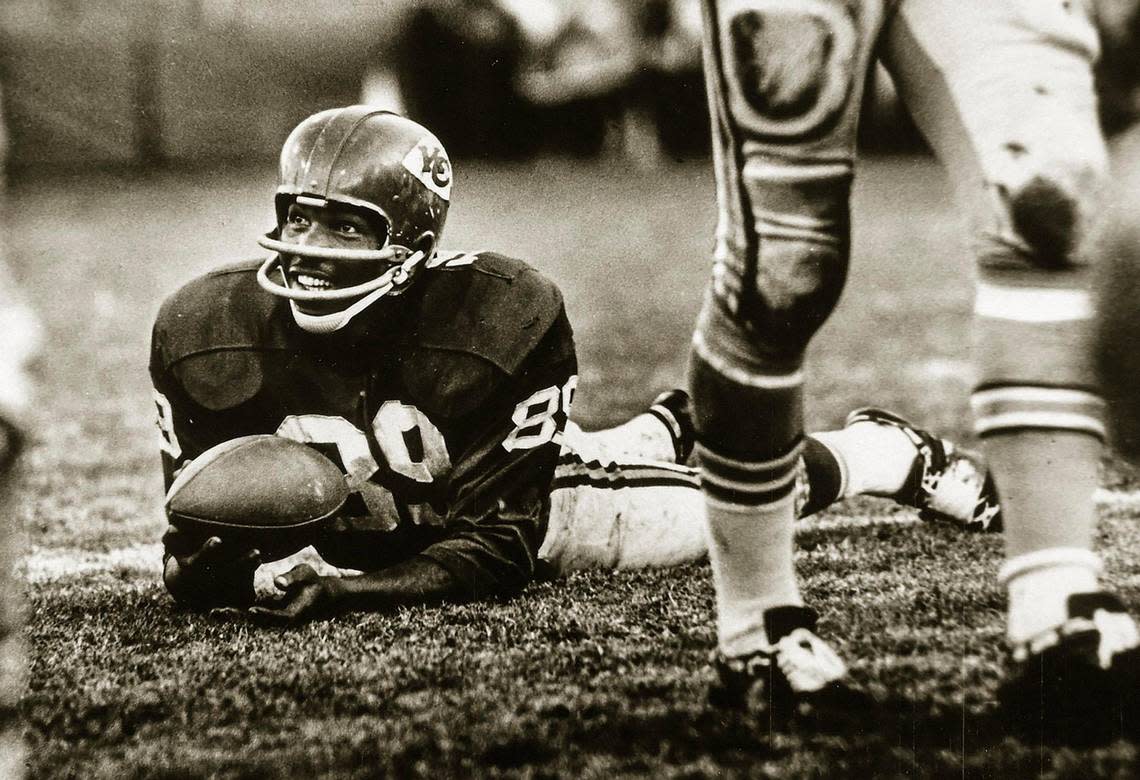No Hall of Fame for KC Chiefs great Otis Taylor? Well, his legacy is no less meaningful

In the afterglow of Buck O’Neil’s long-awaited induction into the National Baseball Hall of Fame on Sunday, the prospect of another overdue immortalization of a Kansas City icon loomed when the Pro Football Hall of Fame on Wednesday was to release its list of 12 senior finalists.
Otis Taylor, after all, had finally re-emerged as a serious candidate under consideration when the Hall of Fame’s senior committee included him in its semifinalist group of 25 announced a few weeks ago.
Between that and the fact that the Hall of Fame this year expanded its cap for senior inductees from one to three (through 2025), there was ample reason for fresh hope that this would be the year it finally happened for a singular force indispensable to Chiefs teams that were, in fact, essential to the evolution of pro football.
If you’re like me, you even wondered if it was just meant to be when the long-bedridden Taylor, who turns 80 next month, recently survived a severe further decline in his health that some friends thought made his death imminent.
Although his condition is such that he wouldn’t have been able to enjoy it or, in fact, be cognizant of it, there was something poetic in the notion that he perhaps was hanging on to get to this day. Maybe a little like the idea of “The Last Leaf” by O. Henry.
So when the list came out Wednesday morning, I skimmed and scanned and squinted hoping to see his name. Looked again and again, as if, presto, it might change just by looking at it again.
But no matter how many times I looked or wished it were otherwise, it was nowhere to be found among the names: Ken Anderson, Maxie Baughan, Randy Gradishar, Chuck Howley, Cecil Isbell, Joe Klecko, Bob Kuechenberg, Eddie Meador, Tommy Nobis, Ken Riley, Sterling Sharpe and Everson Walls.
(I also had been hopeful but figured it was a longshot that Carl Peterson, Marty Schottenheimer and/or Lloyd Wells might advance from being semifinalists in the coach/contributor category. As it happens, none was among the finalists: Roone Arledge, Don Coryell, Mike Holmgren, Frank “Bucko” Kilroy, Robert Kraft, Art Modell, Buddy Parker, Dan Reeves, Art Rooney Jr., Mike Shanahan, Clark Shaughnessy and John Wooten.)
The case for Otis is compelling, particularly for those of us watching through the lens of his role in Kansas City and Chiefs history.
In how he became the archetype of the modern receiver, including making any number of catches you couldn’t even imagine before you saw him doing it.
In how he was the embodiment of fundamental changes in both the broader structure and inner workings of the game, including standing at the nexus of the NFL-AFL signing wars and in the middle of the integration of the game and, of course, animating and igniting the offense that would play in two of the first four Super Bowls.
Nonetheless, the latest version of the senior committee essentially rendered the same verdict so many others have in the past.
And through my first year as one of the 49 members of the overall selection committee, I can tell you I’ve seen voters bring an incredible level of integrity and passion to this process.
Which is to say that even without knowing how the sub-committee reached its decision on the finalists and why it exempted Otis on its list, even wanting it to have gone otherwise, I have no doubt its thinking was remarkably well-informed and well-reasoned.
Its deliberations likely included some 30 receivers, including many others with bodies of work and previous recognition that eclipse Otis’ portfolio ... and still can’t get much traction themselves.
Players like Del Shofner, who was a five-time All-Pro and named to the NFL 1960s All-Decade team. Or men like Gary Collins and Boyd Dowler, who also were 1960s All-Decade receivers; Dowler even was named to the NFL 50th anniversary team. Or Lionel Taylor, a five-time AFL receptions leader.
By comparison, Taylor was a two-time All-Pro (and one-time first-team All-AFL) who led the NFL in receiving yards once (1971).
So it might be surmised that the committee sees him as a man who was significant and had plenty of Hall of Fame moments but not quite a Hall of Fame career up against others .
I’ve heard people, including many who’d like to see this happen, tell me for years now that they think that the ship has sailed on Otis’ candidacy. I still don’t know that this is true.
But it certainly seems he remains stranded between categories or generations or numbers or something … when his case has always been more about the eye test and the context of his role with the Chiefs and in seismic shifts in the game.
Sometimes when we think things might be meant to be, well, it’s just the opposite.
For reasons that in the end that suggest to me it’s perhaps time to try to prioritize cases for other Chiefs of yesteryear (particularly Ed Budde, Deron Cherry and the deeply complicated matter of Jim Tyrer) whose candidacies perhaps have been obscured by the shadow of Otis.
So I’ll just repeat a point I tried to make when I last advocated for him.
No matter how the tide seemed to be with him this time around, Otis now seems not destined for the Hall of Fame after all.
Sad as that might be, the true measure of his profound significance is no less self-evident. And it doesn’t make his legacy any less vital in the history of the Chiefs and pro football … even if it isn’t being more broadly proclaimed.
